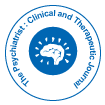Fatigue Symptoms and Paraneoplastic Neurological Diseases are Associated with Neurotrophic Factor and Low Psychological Flexibility
Received: 03-Apr-2023 / Manuscript No. tpctj-23-96933 / Editor assigned: 05-Apr-2023 / PreQC No. tpctj-23-96933 (PQ) / Reviewed: 19-Apr-2023 / QC No. tpctj-23-96933 / Revised: 22-Apr-2023 / Manuscript No. tpctj-23-96933 / Published Date: 29-Apr-2023 DOI: 10.4172/tpctj.1000181
Abstract
One of the most prevalent non-specific symptoms in healthy young adult females is fatigue, whose psychopathophysiology is still little understood. Fatigue is a personal experience of feeling lethargic or exhausted, which affects one's ability to handle stress physically and mentally. Fatigue adversely affects both productivity at work and quality of life, notwithstanding deadly pathology. According to a Swedish study, women between the ages of 20 and 35 were more mentally fatigued than older women and men of all ages. Stress from work-life balance was a common explanation for this young adult female's high prevalence of weariness. However, a survey of college students also discovered that female students were more likely to have persistent weariness. As a result, the reason might have more to do with psychophysiology than the nature of employment.
Introduction
The diagnosis and treatment of neurological illnesses with an autoimmune (paraneoplastic or noncancer related) etiology fall under the rapidly growing field of "autoimmune neurology." The discovery of neural-specific autoantibodies and their target antigens has dramatically increased recently. Most of these neural-specific autoantibodies can now be tested in a lab, and they act as diagnostic markers that point doctors towards particular cancer kinds and help them choose treatments. Numerous established neurological subspecialties, such as cognitive behavioural neurology, movement disorders, epilepsy, neuro-oncology, neuromuscular diseases, autonomic neurology, and demyelinating disorders, interact with autoimmune neurology. Immunotherapy is typically ineffective against antibodies that target intracellular proteins, including as nuclear and intracytoplasmic enzymes, transcription factors, and RNA-binding proteins, which are hallmarks of neural peptide-specific cytotoxic effector T-cell-mediated damage. In contrast, antibodies targeting plasma membrane proteins (neurotransmitter receptors, ion channels, water channels, channel complex proteins) may act as pathogenic effectors and elicit greater response to immunotherapy.
One of the intriguing therapeutic ideas was increasing psychological flexibility to avoid or lessen mental stress-related weariness [1,2]. The goal of psychological flexibility was to counteract the psychosomatic effects of stress. Stress is described as "a notable and persistent condition in which an organism is exposed to risk factors, which tend to alter its balance or homeostasis" by the psychophysiology discipline. While psychological flexibility is described as "the acceptance of our own thoughts, emotions and acting on long-term values rather than short-term impulses, thoughts and feelings that are often linked to experiential avoidance and a way to control unwanted inner events" . Therefore, it makes sense that psychological adaptability and a diverse adaptive repertoire are essential for a positive reaction to stress. Studies on the improvement of fatigue interference have been linked to treatments that attempted to increase psychological flexibility, such as acceptance and commitment therapy or mindfulness-based therapy. The fact that sadness and sleep quality were both improving suggested that these factors were probably either mediators or effect modifiers in the intervention's effect on fatigue . Although there are some wellvalidated surveys (such as the Acceptance and Action Questionnaire), there is currently no gold standard for measuring psychological flexibility. Heart Rate Variability (HRV) is one of the suggested objective physiological biomarkers linked to psychological flexibility [3].
Additionally, the use of Brain-Derived Neurotrophic Factor (BDNF) as a biomarker for cognitive flexibility is gaining attention. A healthy autonomic nerve system function known as sympathovagal balance is measured by HRV [4]. An increase in HRV indicates healthy stress adaptation since it measures the variability in the time between heartbeats . Lower HRV was found in a study of neurofibromatosis patients and was linked to psychological flexibility and challenging pain management. The Pre-Frontal Cortex (PFC), a brain region that mediates executive function, and the hippocampus, an area of the brain associated with learning new information, are two brain regions where the neurotrophic protein BDNF is well known to play essential roles in synaptic plasticity [5]. PFC BDNF in mice increases quickly, peaks in early adolescence, and then progressively declines to adult levels. Lower levels of BDNF have been linked to maladaptive psychological disorders in teenagers, including post-traumatic stress disorder, depression, and schizophrenia, according to a prior study. There hasn't been a study that links BDNF, psychological flexibility, and weariness .
References
- Margarita S, Shruti SR, Irina AV, Cheri AL (2020) Mindfulness and eating disorder psychopathology: A meta-analysis. Int J Eat Disord 53: 834-851.
- Vinod M (2011) Large-scale brain networks and psychopathology: a unifying triple network model. Trends Cogn Sci 15: 483-506.
- Rainer MHH, Frank HH, Michael S, Claude HM (2021) Creativity and Psychopathology: An Interdisciplinary View. Psychopathology 54: 39-46.
- Markus IE (2021) The levels problem in psychopathology. Psychol Med 51: 927-933.
- Giovanni S (2009) The meanings of psychopathology. Curr Opin Psychiatry 22: 559-564.
Indexed at, Google Scholar, Crossref
Indexed at, Google Scholar, Crossref
Indexed at, Google Scholar, Crossref
Indexed at, Google Scholar, Crossref
Citation: Badri MB (2023) Fatigue Symptoms and Paraneoplastic Neurological Diseases are Associated with Neurotrophic Factor and Low Psychological Flexibility. Psych Clin Ther J 5: 181. DOI: 10.4172/tpctj.1000181
Copyright: © 2023 Badri MB. This is an open-access article distributed under the terms of the Creative Commons Attribution License, which permits unrestricted use, distribution, and reproduction in any medium, provided the original author and source are credited.
Share This Article
Recommended Journals
Open Access Journals
Article Tools
Article Usage
- Total views: 774
- [From(publication date): 0-2023 - Apr 03, 2025]
- Breakdown by view type
- HTML page views: 566
- PDF downloads: 208
